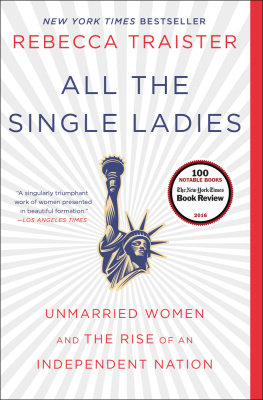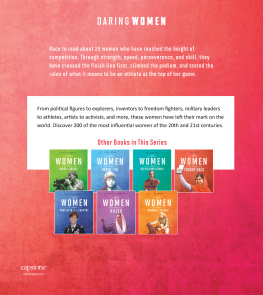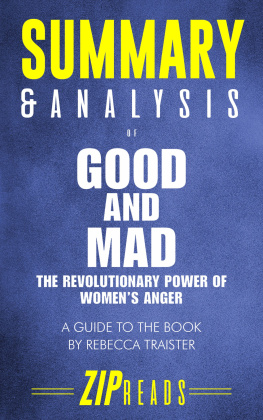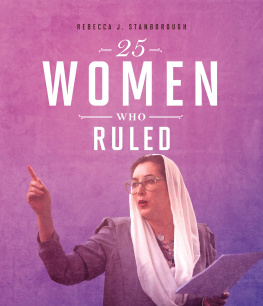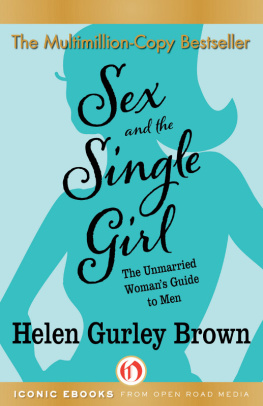Thank you for downloading this Simon & Schuster eBook.
Join our mailing list and get updates on new releases, deals, bonus content and other great books from Simon & Schuster.
C LICK H ERE T O S IGN U P
or visit us online to sign up at
eBookNews.SimonandSchuster.com
We hope you enjoyed reading this Simon & Schuster eBook.
Join our mailing list and get updates on new releases, deals, bonus content and other great books from Simon & Schuster.
C LICK H ERE T O S IGN U P
or visit us online to sign up at
eBookNews.SimonandSchuster.com
ALSO BY REBECCA TRAISTER
Big Girls Dont Cry: The Election That Changed Everything for American Women

Simon & Schuster
1230 Avenue of the Americas
New York, NY 10020
www.SimonandSchuster.com
Copyright 2016 by Rebecca Traister
All rights reserved, including the right to reproduce this book or portions thereof in any form whatsoever. For information, address Simon & Schuster Subsidiary Rights Department, 1230 Avenue of the Americas, New York, NY 10020.
First Simon & Schuster hardcover edition March 2016
SIMON & SCHUSTER and colophon are registered trademarks of Simon & Schuster, Inc.
For information about special discounts for bulk purchases, please contact Simon & Schuster Special Sales at 1-866-506-1949 or .
The Simon & Schuster Speakers Bureau can bring authors to your live event. For more information or to book an event, contact the Simon & Schuster Speakers Bureau at 1-866-248-3049 or visit our website at www.simonspeakers.com.
Interior design by Joy OMeara
Jacket design by Janet Perr
Image by Shutterstock
Library of Congress Cataloging-in-Publication Data
Names: Traister, Rebecca, author.
Title: All the single ladies : unmarried women and the rise of an independent nation / Rebecca Traister.
Description: New York : Simon & Schuster, 2016.
Identifiers: LCCN 2015045131 | ISBN 9781476716565 (hardback) | ISBN 9781476716572 (trade paperback)
Subjects: LCSH: Single womenUnited StatesHistory. | WomenUnited StatesSocial conditions. | FeminismUnited StatesHistory. | United StatesCivilization. | United StatesHistory. | United StatesSocial conditions. | BISAC: HISTORY / United States / 21st Century. | HISTORY / Social History. | SOCIAL SCIENCE / Womens Studies.
Classification: LCC HQ880.4.U6 T73 2016 | DDC 306.81/530973dc23
LC record available at http://lccn.loc.gov/2015045131
ISBN 978-1-4767-1656-5
ISBN 978-1-4767-1658-9 (ebook)
For my parents, who never gave me a hard time about it
Contents
Nellie Bly: What do you think the new woman will be?
Susan B. Anthony: Shell be free.
1896
A Note on Interviews and Attribution
While researching this book, I conducted interviews with close to one hundred women around the country. Some I sought out because their work corresponded to the issues I wanted to address; some had written affectingly on the topics of singlehood or marriage; some were friends or friends of friends; some were women I bumped into in airports; some were strangers I befriended because I wanted to include as broad a range of geographic, religious, economic, and racial experience as possible; some were women tracked down by my nimble research assistant, Rhaina Cohen. A few women got in touch with me after hearing through their own social or professional circles that I was writing about single women.
From those original hundred interviews, I wound up quoting the tales of about thirty women at length in these pages. Surely those thirty stories include an overrepresentation of people like me: It is fair to say that there are likely more college-educated feminists, writers, and New Yorkers here than most readers know in their real lives. But I have worked to ensure that these are not the only stories.
Nearly all of the interviewees agreed to be identified by their full names. Those who did not are referred to by their first or middle names only. Likewise, I deferred to individual preferences when it came to later references: Some women are called by their first names as their tales progress, reflecting the intimate nature of the stories they offer, some preferred to be called by their last.
The interviews took place between 2010 and 2015 and reflect the experiences and realities of the women at the time they were interviewed. During the fact-checking process, some of the interviewees who felt that their circumstances, perspectives, or thoughts on singlehood had changed significantly since the time of their interviews asked to update their status. I have included a Where Are they Now? section to account for their lives up through publication.
Finally, I did not set out to write a book that relies almost entirely on the words, scholarship, stories, and insight of women. In fact, when I realized, late in the process, that I had written more than three hundred pages of a book in which only a handful of men were cited, I felt bad. After all, men are socially, economically, and emotionally crucial to women and to the story of female independence, and they comprise half of the world that is being remade around us. But though they have been at the center of many female lives for many generations, men are not, as it turns out, at the center of the story I have laid out here.
Introduction
I always hated it when my heroines got married. As a child, I remember staring at the cover of The First Four Years , willing myself to feel pleasedas I knew I was meant tothat Laura Ingalls had wed Almanzo Manly Wilder and given birth to baby Rose. I understood that despite the hail storms, diphtheria outbreaks, and other agrarian misery that Wilder chronicled in the last of her Little House books, Lauras marriage and motherhood were supposed to be read as a happy ending. Yet, to me, it felt unhappy, as if Laura were over. And, in many ways, she was.
The images on the covers of previous Little House books, drawn by Garth Williams in the editions I owned, had been of Laura in motion, front and center: gamboling down a hillside, riding a horse barefoot, having a snowball fight. Here she was, stationary and solidly shod, beside her husband; the baby she held in her arms was the most lively figure in the scene. Lauras story was coming to a close. The tale that was worth telling about her was finished once she married.
It was the same with Anne of Green Gables Anne Shirley, whose days of getting her best friend Diana Barry drunk and competing at school with rival Gilbert Blythe were over when, at last, after three volumes of resistance and rejected proposals, she gave in and married Gilbert. Beloved Jo March, who, in Little Women, subverted the marriage plot by not marrying her best friend and neighbor Laurie, came to her clunky, connubial end by getting hitched to avuncular Professor Bhaer. And Jane Eyre: Oh, smart, resourceful, sad Jane. Her prize, readers, after a youth of fighting for some smidgen of autonomy? Marrying him : the bad-tempered guy who kept his first wife in the attic, wooed Jane through a series of elaborate head games, and was, by the time she landed him, blind and missing a hand.
It was supposed to be romantic, but it felt bleak. Paths that were once wide and dotted with naughty friends and conspiratorial sisters and malevolent cousins, with scrapes and adventures and hopes and passions, had narrowed and now seemed to lead only to the tending of dull husbands and the rearing of insipid children to whom the stories soon would be turned over, in pallid follow-ups like Jos Boys and Anne of Ingleside .
Next page

